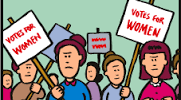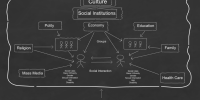Main objective of this assignment is to discuss on Child labor, as it become a Threat for our Future Generation. There are some issues which are approximately related with child labor in Bangladesh, like Hazardous child labor, Child labor in garment industries, UNICEF, Child domestic workers, Trafficking of children, Organizations working with child workers, Child labor survey, UNICEF etc. At the present time in Bangladesh child labor is a huge problem and it will create a big hazard in near future.
Introduction
Child labor refers to the employment of children at regular and sustained labor. This practice is considered exploitative by many international organizations and is illegal in many countries. Child labor was utilized to varying extents through most of history, but entered public dispute with the advent of universal schooling, with changes in working conditions during the industrial revolution, and with the emergence of the concepts of workers’ and children’s rights. They are scarifying their childhood for bare survival of self & family. There were 218 million children working illegally in the eyes of international treaties, as at the most recent formal assessment in 2004. Child labor is defined as all economic activity for children less than 12 years, any work for those aged 12-14 of sufficient hours per week to undermine their health or education, and all “hazardous work” which could threaten the health of children under 18.
Basically from the developing & also industrialized area of the world generally child labor has come. For example- Africa, Asia, Latin America, East European etc. Bangladesh accounts less than 2 percent which is 6.6 million working children in contest of 120 million working children of the world. Bangladeshi child labor has been used widely except mining, quarrying, electricity gas & water & their earning for working 48 hours on an average is Tk.500 per month.
Because of doing hazardous work by child labor, they suffer significant growth deficits than school children for their working environment. Most of them are working in an alarming place for which usually child labor has been suffered from many diseases, like- dizziness, respiratory infections & worm infection etc. They may also loss their body parts. Child labors are often found to be victims of verbal & sexual abuse. For this reason after a while they will go for violence & criminal activities for living.
Child labors are far away from their legal rights as a school going children for their working activities. Also, many child labors are trapped in forced labor, debt bondage & other kinds of jobs that cause lasting & devastating damage. Every nation should be aware for protect child labors against all harmful factors & also work for giving them their legal rights.
In context of Bangladesh
There are some main reasons for which child labor is also applicable in Bangladesh-
Supply factors:
As Bangladesh is economically non-solvent country, about 55 million people live below the poverty line. If, from a family at least one child labor has come then he or she will earn 20 to 25 percent of the family income. Their only aim is to feed themselves & survive in any how. Parents also encourage their child for earning. For these types of families, poor parents fail to appreciate the long-term value of education, & instead for the short term economic gins of child labor. They hold their children for field & household work & also for engineering workshop to learn employment shill. It acts like an alternative education with much more practical value than traditional primary education. Since January 1993, govt. has given an approval of Compulsory Primary Education Program. But, the poor families still cannot bear the cost of uniform & transportation cost for a school going children. The incomes of that type of families are low & if the school going children become a labor then it will be more beneficiary for them & these emergencies are the main reason of child labor. In Bangladesh often may happen natural calamities & it would be difficult for these families to reinstate. For many other problems like this, children from that families are bring trapped & enter into the working world.
Demand factors:
Why child labors are more demandable to the working area rather than adult labor? Because, children are not that much conscious about their rights, they are more organized, more trustworthy, more willing to take order, less likely to be absent from work & do monotonous work than adult labors. For all these reasons child labors are more popular than adult labors.
Scale of Child labor in Bangladesh
Children in the age group of 5-14 years who are working for surviving were found during the survey time of Bangladesh Bureau of Statistics (BBS) in the “National Sample Survey of Child Labor in Bangladesh: 1995-96”. When a child was found either working one or more hours for pay or profit or working without pay in a family farm or enterprise during the certain period or not working but had a job or business from which he was absent temporarily for a certain period was called a child labor. In 1995-96 BBS has shown that child labors were 6.6 million that is 19% of the total child population. From 5-9 age groups 11.6 % of the child labor has come. Employed child labor force was 95.6%. Male & female child labors were 59.8% & 40.2% according to the total child labor force. Almost in all sector child labor had been used except mining & utilities. Basically they were come from rural areas, because the percentage of urban areas’ child labor was 17%. About 65.4% of child worker for Agriculture, 10.3% for services, 8.2% for manufacturing, 1.8% for transport & communication & 14.3% children were for other activities including household work had been used for that time period.
The statistical information of child labor survey in 1995-96 (as on January 1996) is given. Here, only that types of data are shown, which are affected more in the economy:
| Characteristics | Total | Male | Female |
| Child population ,5-14 years(000) | 34455 | 17862 | 16593 |
| Child labor force (000) | 6584 | 3919 | 2665 |
| It was indicating that labor force were mostly comes from Male children | |||
| Percentage of child labor force by age group | |||
| Percentage of 5-9 years | 11.6 | 11.1 | 12.3 |
| Percentage of 10-14 years | 88.4 | 88.9 | 87.5 |
| From 5-9 age groups female children & 10-14 age groups Male children were working as child labor. | |||
| Child labor force by residence | |||
| Total (000) | 6584 | 3919 | 2665 |
| Urban | 1136 | 637 | 499 |
| Rural | 5448 | 3282 | 2166 |
| Most of the labor force had come from Rural area | |||
| Working child labor in context of Bangladesh (000) | 6298 | 3769 | 2529 |
| Urban | 1059 | 597 | 462 |
| Rural | 5239 | 3172 | 2067 |
| Child labors were mainly comes from rural areas & male children were more than female | |||
| Wage employed child labor as percentage of total child labor – Percent | 8.5 | 7.7 | 9.5 |
| Most of wage employed child labor were female | |||
| Child workers by major occupation (%) | 100 | 100 | 100 |
| Most of child labors were work in Service | 71.2 | 70.2 | 2.9 |
| Huge number of female worker were in Agriculture, forestry & fisheries | 6.2 | 9.2 | 72.8 |
| Males were basically for service & females were for agriculture, forestry & fisheries(child labor) | |||
| Child workers by major industry (%) | 100 | 100 | 100 |
| Huge percentage comes from Agriculture by female | 8.2 | 9.7 | 63.0 |
| Child workers by type & sector of employment (%) | 100 | 100 | 100 |
| Private (informal) | 94.0 | 93.1 | 95.5 |
| Employment status of child workers (%) | 100 | 100 | 100 |
| Self- employed | 63.5 | 58.4 | 2.5 |
| Unpaid family workers | 2.0 | 2.9 | 71.2 |
| This was shown that self- employed came from generally Male & unpaid family workers mostly from female | |||
| Average weekly hours worked (all working children) | 25.6 | 26.9 | 23.8 |
| Average monthly income (paid workers in Tk.) | 478.2 | 507.5 | 448.1 |
| From this statement we can see that the average monthly income was grater for male children than female children | |||
Trends in child labor situation in Bangladesh
In this country, the number of child labors was increased from 2.5 million to 6.6 million in the time duration 1974-96. Urban child labor force which was 9% of the total child labor force had been increased to 17% in the year 1995-96 & it remains stable at around 19% in 1989.
Child labor environment in context of Bangladesh
There are some issues which are approximately related with child labor in Bangladesh-
- Hazardous child labor
- Child labor in garment industries
- Harkin’s bill
- Child labor survey
- UNICEF
- Child domestic workers
- Trafficking of children
- Organizations working with child workers
Now, we will explain all these issues:
Hazardous child labor
Child labors are not appropriate for all types of work. According to 1995 the Ministry of labor & manpower in collaboration with UNICEF, “Hazardous Child Labor in Bangladesh” has been created to identify hazardous economic activities involving children. 27 economic activities which known as hazardous are-
- Automobiles workshop worker
- Battery recharging shop worker
- Bedding manufacturing worker
- Blacksmith
- Brick/ stone crushing
- Car painting/ metal furniture painting/ spray painting works
- Child prostitution
- Construction
- Dyeing workshop worker
- Electric mechanic
- Engineering workshop worker
- Goldsmith’s assistant
- Hotel/ Mess cook
- Laundry boy
- Porter
- Printing a press worker
- Rickshaw/ rickshaw van puller
- Saw mill worker
- Small soap factory worker (crude process)
- Sweeper
- Scavenger (waste picker)
- Tannery factory worker
- Tempo/ truck/ bus helper/ unlicensed tempo driver
- Welding worker
- Shrimp processing factory worker (processing by hand)
- Vulcanizing workshop assistant
- Vangari (splinter/waste collectors & processors)
It gets particularly abhorrent is when underage children are engaged in physically and mentally hazardous avocations with routine regularity. The children have been slogging for 12 to 15 hours a day without mandatory eye glasses, hand gloves and masks for an outrageous sum of Tk 250-300 (US$3.60-$4.30) in a week. The ethical and health issues are intertwined here. That, as many as 25 factories could spring up at Keraniganj to produce stove burners largely through the labour of children handling dangerous acid solutions is a ringing indictment on the incompetence of the regulatory authorities.
Child labor in garment industries
In 1991, a study was entitled named “The Conditions of Garment Workers in Bangladesh” found 13% of the workers to be working children. For earning around 500 taka & 585 taka as sewing helpers (which is around 66%) & finishing helpers (around 15% of the total child labor), a third of the child workers were in fact school dropouts. Though they were working about 13 hours as finishing helper & 11 hours as sewing helper, in peak seasons they had to work also in weekly holidays.
Harkin’s bill
In due to free child labor, the senator of USA named Harkin’s bill (1993) banning the products of those industries who used child labor. Around 50000 children were dismissed from work of garments. But because of that step, child labors were trapped for doing more hazardous & exploitative activities.
Child labor survey
To eliminate child labor from work & make sure for their education, In 1995 Bangladesh Garment & Exporters Association (BGMEA), ILO & UNICEF had been taken a step to give them a monthly payment of taka 300 per child.
UNICEP
UNICEP had stated a program of educating terminated children through Gono Shahajya Sangstha(GSS) & Bangladesh Rural Advancement Committee(BRAC). In 996, September 22 to October 31 a special drive was organized & because of that by November 19 the number of children attending the education program went up to 7622 in 296 schools set up for them.
Child domestic workers
“The Rapid Assessment of Child Labor Situation in Bangladesh” estimated that, in one Dhaka out of 1181 child workers, domestic helpers numbered 770. So we can see that child domestic service was so popular in Bangladesh. A huge number of child workers had come from vulnerable families & single parents families. They could be orphan & abandoned children too. From a survey it was found that 38% of child labor was 11 to 13 years old & nearly 24% were 5 to 10 years old. Domestic work was also tough for child labor because, on an average 50% of the child domestic workers work 15-18 hours a day. Boys often perform the outdoor activities & girls perform indoor’s. Domestic child labors were least paid worker & the ratio of education for child labors was 31% for girls& 37% for boys.
Trafficking of children
For better payments many families send their children to outside of the country. These were basically, children smuggling across the border by the traffickers. They sold male child for using them as jockey in the camel race & female child as slaves on the name of marriage.
Organizations working with child workers
Some philanthropists like New Zealander, Mr. L. N. Cheyna initiated programs in the non-government sector to promote welfare of the working children. On his visit he founded an international NGO, Underprivileged Children’s Educational Programs (UCEP), as a beacon of hope for working children. They were working as a provider of general education on a limited scale in Dhaka, has by now emerged as the leading national NGO promoting the cause of child worker in Bangladesh. UCEP currently operates 30 general schools, 3 technical schools, and 5 Para-trade training centers & has a total enrollment of around 22000.
Observations regarding this case
Now-a-days child labors are becoming risky for the whole world. It acts like a threat. Till the nation cannot control the socio-economic condition they would not eliminate the child labors from their job. For this reason they can again engage with some other illegal activities. As they are working children, so they cannot attend full time schools. So, the govt. has to take some steps for that. Like- night schooling, half day schooling etc. for working children. UCEP model of integrated human resources development for child workers & actively seek to put an immediate end to the most intolerable forms of child labor.
Only key information of UCEP project performance (July – December 1998):
| School training centers | Number |
| General schools (each school runs 3 shifts a day) | 30 |
| Which is not sufficient for the whole country | |
| No. of students of General school | 20018 |
| As we know the amount of child labor of the country, we can say many child labors are not still school going child | |
| New admission for general schools | 2740 |
| Not that much high in amount | |
| Gender ratio of male female in which Technical schools are grater than any schools | 68:32 |
| Attendance rate of Technical schools | 95.70% |
| Dropout rate of general schools which is grater than any schools | 4.42% |
| Graduation from general schools (grade-V) | 2342 |
| Rate of placement in job of Technical schools | 95.50% |
| Total expense 9in million taka) | 44.87 |
| Cost per student for technical schools in taka | 53.78 |
Findings
From this passage we can find some certain cause of Child labor in our country. That’s are-
- Poverty of our country
- For food security
- Economical insolvency of most families
- Child labors are more popular than adult labors
- Easy to get
- Supply of child labor is huge
- They are not that much concern about their rights
- More cheaper than adult labors
These are the basic reasons for growing child labor in Bangladesh.
Because of growing children there are happening some major problems in Bangladesh-
- Future generation is under a threat
- Child exploitation are growing more & more
- Working children suffer significant growth deficits
- Child labor are not getting their legal rights
- Many illegal activities has been done by them
- Working environment are getting more difficult
- Education rate are in a decreasing rate
Recommendation
We can solve these problems by doing-
- Growing awareness about effect of child labor
- Making concern every children about their legal rights
- Not by eliminating them, by developing socio-economic condition solve this problem
- Following a strict law for un-ethical child work
- Motivating business persons
- Formulating more comprehensive national plan of action
- Making more favorable schools for child worker.
These are the basic requirements for solving the child labor problem in Bangladesh.
Conclusion
Now, in the whole world child labor is a huge problem. If we do not take any step for this problem as soon as possible, it will create a big hazard in near future. Children are the key of future world. So, we should protect this problem. Govt. is already taking some steps for that & they should continue it. This is our duty to ensure the legal rights of every child.
















